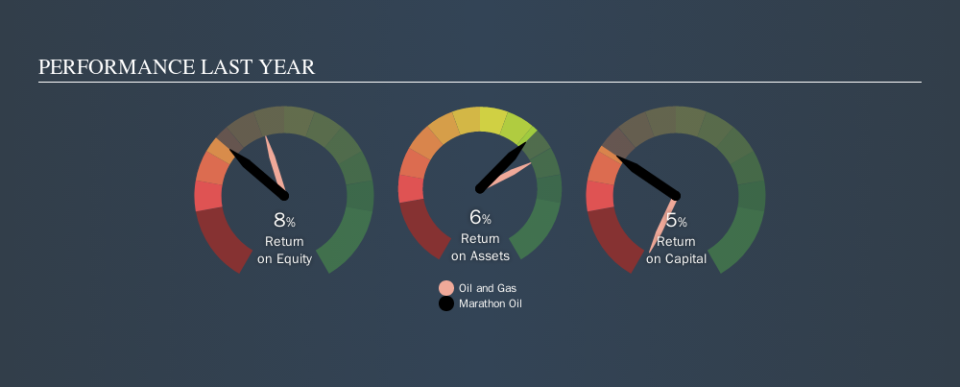How Do Marathon Oil Corporation’s (NYSE:MRO) Returns On Capital Compare To Peers?

Today we are going to look at Marathon Oil Corporation (NYSE:MRO) to see whether it might be an attractive investment prospect. Specifically, we're going to calculate its Return On Capital Employed (ROCE), in the hopes of getting some insight into the business.
First, we'll go over how we calculate ROCE. Then we'll compare its ROCE to similar companies. And finally, we'll look at how its current liabilities are impacting its ROCE.
Understanding Return On Capital Employed (ROCE)
ROCE is a metric for evaluating how much pre-tax income (in percentage terms) a company earns on the capital invested in its business. Generally speaking a higher ROCE is better. Overall, it is a valuable metric that has its flaws. Author Edwin Whiting says to be careful when comparing the ROCE of different businesses, since 'No two businesses are exactly alike.'
How Do You Calculate Return On Capital Employed?
Analysts use this formula to calculate return on capital employed:
Return on Capital Employed = Earnings Before Interest and Tax (EBIT) ÷ (Total Assets - Current Liabilities)
Or for Marathon Oil:
0.053 = US$996m ÷ (US$21b - US$2.5b) (Based on the trailing twelve months to June 2019.)
So, Marathon Oil has an ROCE of 5.3%.
View our latest analysis for Marathon Oil
Is Marathon Oil's ROCE Good?
ROCE can be useful when making comparisons, such as between similar companies. We can see Marathon Oil's ROCE is meaningfully below the Oil and Gas industry average of 8.3%. This performance is not ideal, as it suggests the company may not be deploying its capital as effectively as some competitors. Putting aside Marathon Oil's performance relative to its industry, its ROCE in absolute terms is poor - considering the risk of owning stocks compared to government bonds. There are potentially more appealing investments elsewhere.
Marathon Oil reported an ROCE of 5.3% -- better than 3 years ago, when the company didn't make a profit. That implies the business has been improving. The image below shows how Marathon Oil's ROCE compares to its industry, and you can click it to see more detail on its past growth.
When considering ROCE, bear in mind that it reflects the past and does not necessarily predict the future. ROCE can be misleading for companies in cyclical industries, with returns looking impressive during the boom times, but very weak during the busts. ROCE is, after all, simply a snap shot of a single year. Remember that most companies like Marathon Oil are cyclical businesses. Since the future is so important for investors, you should check out our free report on analyst forecasts for Marathon Oil.
Do Marathon Oil's Current Liabilities Skew Its ROCE?
Short term (or current) liabilities, are things like supplier invoices, overdrafts, or tax bills that need to be paid within 12 months. Due to the way the ROCE equation works, having large bills due in the near term can make it look as though a company has less capital employed, and thus a higher ROCE than usual. To counteract this, we check if a company has high current liabilities, relative to its total assets.
Marathon Oil has total assets of US$21b and current liabilities of US$2.5b. Therefore its current liabilities are equivalent to approximately 12% of its total assets. With a very reasonable level of current liabilities, so the impact on ROCE is fairly minimal.
The Bottom Line On Marathon Oil's ROCE
While that is good to see, Marathon Oil has a low ROCE and does not look attractive in this analysis. Of course, you might also be able to find a better stock than Marathon Oil. So you may wish to see this free collection of other companies that have grown earnings strongly.
If you like to buy stocks alongside management, then you might just love this free list of companies. (Hint: insiders have been buying them).
We aim to bring you long-term focused research analysis driven by fundamental data. Note that our analysis may not factor in the latest price-sensitive company announcements or qualitative material.
If you spot an error that warrants correction, please contact the editor at editorial-team@simplywallst.com. This article by Simply Wall St is general in nature. It does not constitute a recommendation to buy or sell any stock, and does not take account of your objectives, or your financial situation. Simply Wall St has no position in the stocks mentioned. Thank you for reading.

 Yahoo Finance
Yahoo Finance 
